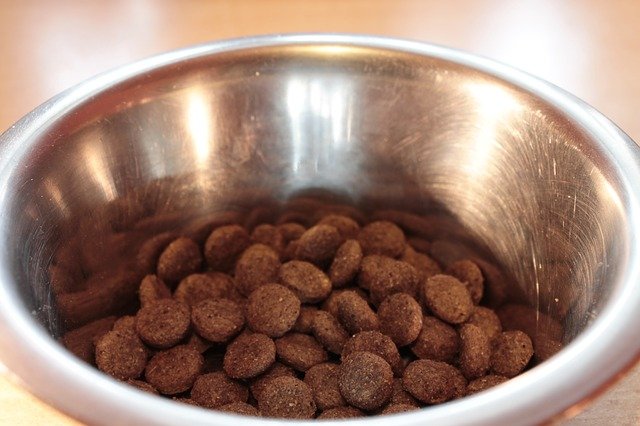
Be Aware Of Dog Foods With High Levels of Vitamin D
Recently there have been issues with high levels of vitamin D in some brands of dog food. The most recent incident was a voluntary recall by Hill’s Pet Nutrition, due to concerns that certain canned dog foods contained levels of vitamin D that exceeded the company’s product specifications.
Why Dog Food Contains Vitamin D
Vitamin D is an essential nutrient for the optimal health of dogs and cats. It enhances the absorption of calcium in the intestines, as well as enhances the retention and bone deposition of calcium and phosphorous. Unlike humans, dogs and cats cannot produce the majority of the necessary vitamin D from sunlight, and thus need vitamin D added to their diet.
However, just like any other substance, too much vitamin D can be harmful. There is a set standard for the amount of vitamin D added to commercial dog and cat food sold in the United States. If an animal ingests too much, their internal biology begins to malfunction.
Recognizing The Symptoms of Vitamin D Toxicity
Early signs of vitamin D toxicity can include not eating, lethargy and/or weakness. Other clinical signs include vomiting, diarrhea, drooling, increased thirst, increased urination, and weight loss. Vitamin D toxicity can even lead to kidney failure and, in some cases, death.
How to Shop for Quality Dog Food
This recall can lead many of us to wonder what foods are safe for our pets. Proper nutrition keeps your pet energized day-to-day, and can even help prevent diet-associated diseases as well as aid in the management of other diseases. However, often times the best thing a pet food has going for it is an attractive label. Also, we as consumers can fall into the trap of thinking that because something costs more it must also have higher quality ingredients or more nutritional value.
How to Read A Dog Food Label
The best place to begin is by taking a look for something called the AAFCO Statement. The Association of American Food Control Officials is a consortium of officials from the federal, state, and local level who set nutritional standards for complete and balanced pet foods for animals at each stage of life—from puppy to old dog. However, compliance with their guidelines is voluntary. So, only pet food companies that truly care about their customers will perform the feeding trials according to the AAFCO’s recommendations.
The place to look for the AAFCO Statement is on the nutritional label, generally printed directly above or below the ingredients list. It’s important to read what the statement says, as it contains important information about whether the product in your hands meets the dietary requirements specific for your pet’s age.
Pet Food Fads to Avoid
Finally, try to avoid pet food fads. For example, there’s recently been a large movement in pet stores towards grain-free diets. However, nutritional scientists haven’t found a lot of evidence that dogs and cats need a grain free diet. In fact, in recent months there actually have been reports of grain-free diets being linked to heart disease in some dogs. Research continues to be conducted on this topic and we will surely be learning more in the coming months.
How to Research Your Pet Food Maker Online
Step 1: Do They Own Their Own Plants?
If you have some time to research before heading to the store, it’s a good idea to get to know more about the manufacturer behind your favorite dog food brands. The first thing to learn is whether the company uses its own manufacturing plants. Companies that own their own plants tend to have stronger quality controls than companies that rely on third parties to manufacture their products. This step simply requires you to type the following into your search engine: “Does [insert pet food company name here] own its own manufacturing plants?” Companies that own their own manufacturing plants will often state the fact on their websites.
Step 2: Do They Have Good Quality Control?
Responsible companies also employ full-time nutritionists, and make their quality control procedures clear on their website. Good quality control will test the ingredients for quality, and make sure they don’t contain any mold-produced aflatoxins and other pathogens. Quality control will also ensure end-to-end nutritional content (which can help prevent issues like dangerously high levels of vitamin D). Again, the best way to research this is by simply typing “What are [pet food company’]’s quality control procedures?” into your search engine.
Step 3: Do They Conduct Nutritional Research?
Finally, if you can, try to find out if the pet food company is regularly publishing nutritional research in scientific journals that are reviewed by other, non-affiliated nutrition experts. Once again, your search engine the best resource. Try typing the phrase: “[Pet food company] peer-reviewed articles.” Most reputable companies will have a web page where they share their research.
You Can Always Ask Your Veterinarian For Advice
Also note that even pet food companies that own their own supply chain, comply with AAFCO recommendations, and perform regular quality control can occasionally mess up. Hill’s Pet Nutrition owns its own manufacturing plants, but the source of its high vitamin D levels came from a supplier of ingredients. Since announcing the voluntary recall, Hill’s Pet Nutrition has required their supplier to implement additional quality testing prior to the release of ingredients. The company has also added further testing of ingredients after they’ve arrived at their facilities.
We understand pet owners might find all this information overwhelming, and even a bit intimidating. You can always contact Spotsylvania Animal Hospital for diet-related questions about your pet food products. Our veterinarians are available to discuss diet recommendations based on the individual needs of your pet.
Spotsylvania Animal Hospital provides medical and surgical care for every stage of your pet's life including preventive wellness care exams and vaccines, spays/neuters, and a variety of specialized care for your dog or cat. Learn more about us!

